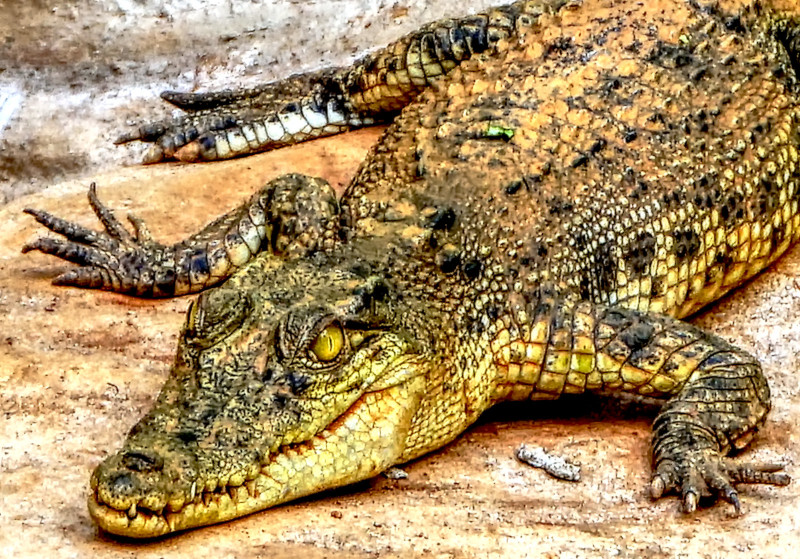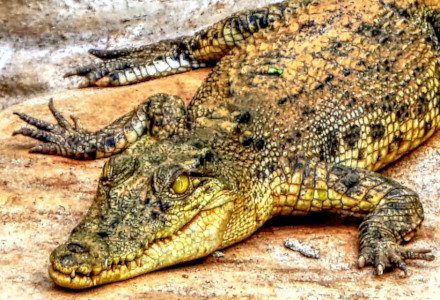
Philippine Crocodile Facts
- This magnificent work of Nature and evolution most frequently goes by the descriptive name of the Philippine Crocodile. It also has other, less often used common names, though. While that’s not uncommon, it has more alternate names than some.
- Sometimes individulas refer to the fabulous reptile as either the bulkarot, the Mindoro crocodile, or the Philippine freshwater crocodile. Scientists, meanwhile typically refer to it by its hard to pronounce official scientific name of the Crocodylus mindorensis.
- The first formal recognition of this marvelous creature as a species, however, did not occur until the year 1935. The respected American herpetologist, Karl Patterson Schmidt, holds the honor of that particular scientifically noteworthy acknowledgment.
- Interestingly, though, experts previously considered the animal to merely be a subspecies of yet another crocodile. In 1989, however, experts determined that it was, in fact, not a subspecies of the New Guinea crocodile, despite beliefs to the contrary.
- Sadly, though, the population of the marvelous Philippine Crocodile plunged drastically in modern times. This occurred mainly due to fishing practices, and exploitation. The IUCN, therefore, listed it as Critically Endangered, on its Red List, in 2008.
- In fact, it’s further considered to be the most highly threatened of all known crocodile species. Thankfully, however, the reptile now enjoys a measure of protection under the law. It nevertheless faces other threats, such as habitat loss and climate change.
Related Articles
Philippine Crocodile Physical Description
Though the incredible Philippine Crocodile easily impresses those who encounter it, the animal does not do so purely to sheer size alone. That’s because, compared to related species, it’s relatively small. Further, it’s actually among the smallest of all crocodilians.
Like many reptiles, though, it displays a slight degree of the physiological characteristic of sexual dimorphism. In its specific case, this trait manifests itself in terms of physical size, alone. In some species, this trait appears in both size and overall appearance.
More specifically, though, the females of this amazing species attain a smaller size than males. That further applies to length and weight. The overall difference, however, remains comparatively minor. This sometimes makes identification difficult for experts.
Between the genders, a mature specimen of the Philippine Crocodile reaches a length measuring approximately 10 ft (3.1 m). The gender-based differnce is more pronounced in weight, however. Males weigh up to 420 lb (190 kg), yet females rarely exceed 200 lb (90 kg).
Like its many relatives, this crocodilian develops thick, bony plates, like armor, covering its body. These further develop especially thick on its back. It also manifests a relatively broad snout. In coloring, it’s a golden-brown shade when young, but darkens as it matures.
- Kingdom: Animalia
- Phylum: Chordata
- Class: Reptilia
- Order: Crocodilia
- Family: Crocodylidae
- Genus: Crocodylus
- Species: C. mindorensis
Philippine Crocodile Distribution, Habitat, and Ecology
The very name of the remarkable Philippine Crocodile provides a good indication its native range. That’s due to the fact that the reptile is native to region of the Philippines. For an entire species, however, that’s an extremely limited section of the globe for it to inhabit.
Sadly, though, even within this range it’s lost much of its former territory. That’s because the reptile once appeared throughout the region. Unfortunately, though, it’s now been eradicated in much of the area. Due to this, the animal now appears in only a few areas.
Those highly isolated sections of the overall region further consist solely of the islands of Dalupiri, Luzon and Mindanao. Much of those regions, though, now form National Parks. Like most of its relatives, it displays strong preferences for its choice of habitat.
In each area, though, the majestic reptile lives in the same three types of ecosystem. These zones of habitation consist of either marshes, ponds, or freshwater rivers. It also inhabited the same types of ecosystems in the portions of the region from it has been extirpated.
Like others of its kind, this magnificent crocodilian evolved an entirely carnivorous diet. Also like its many kindred around the world, it feeds opportunistically. Due to the nature of its very limited range, though, certain prey understandably forms the bulk of its diet.
This mainly consists of small mammals, aquatic invertebrates, other reptiles, a few birds, and quantities of fish. Here, the Philippine Crocodile displays an unexpected tendency. That’s due to the fact that it intentionally seeks out ailing fish in a higher ratio to others.
Species Sharing Its Range
Check out our other articles on 5 Remarkably Riveting Rays, Crowned Eagle, Padirac Cave, Purple Frog, Southern Tamandua, Dwarf Crested Iris, Kerengga ant-like jumper

